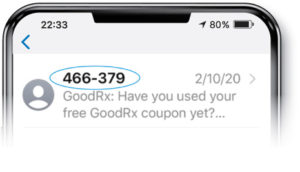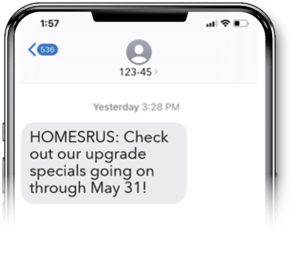
Texting 101 – When can you text someone?
Text messages can be sent if the user has opted in to receive text messages from you (generally via a check box on a web page) or has requested to receive text messages by texting a pre-defined “keyword” to your short code (we’ll circle back on these short codes shortly!).
Acronyms to add to your arsenal
SMS – Short Messaging Service is a system that enables mobile phones to send and receive text messages.
MMS – Multimedia Messaging Service is a system that enables mobile phones to send and receive pictures and sound clips in addition to text messages.
Generally speaking, most service providers offer seamless SMS/MMS capabilities.
RCS – Rich Communication Services seeks to replace SMS/MMS messaging. It gives businesses a new opportunity to enhance customer experience and communication through text messaging with a few additional features:
- Branding opportunities with the addition of logos and customized color palettes
- Incorporation of image carousels, group chats, read receipts, photos, GIFs and maps
As an evolving technology, RCS is currently a niche solution. Some of its features make it similar to Apple’s iMessage. While currently pre-loaded on some Android phones, RCS is not yet supported by Apple.
Short codes – the nerve center of texting
 A short code is a simple 5 to 6-digit number used to send SMS or MMS messages. These short codes are managed and assigned through an independent third-party entity under the direction of the Common Short Code Administration and the Cellular Telecommunications Industry Association (CTIA). These codes basically identify the ‘Sender’ of a text message.
A short code is a simple 5 to 6-digit number used to send SMS or MMS messages. These short codes are managed and assigned through an independent third-party entity under the direction of the Common Short Code Administration and the Cellular Telecommunications Industry Association (CTIA). These codes basically identify the ‘Sender’ of a text message.
There are two classifications of short codes: shared and dedicated. A shared short code, much as the name indicates, is a code that’s shared by thousands or even tens of thousands of businesses. While the big advantage of a shared short code is the ability to spread its cost among all the businesses that use it, the lack of internal control and potential misuse by businesses you don’t even know create significant pitfalls and challenges.
Why a dedicated short code is important
Wireless carriers perform short code audits to determine if the use of a short code meets compliance standards. If it’s determined that a business is in violation of their rules, the wireless carrier will suspend all text messaging traffic on that short code. And with a shared code, that affects ALL the other businesses who share that short code as well. When a shared short code is suspended, it can take up to a month for the wireless carriers to remove that suspension, depending on the severity of the violation. During the suspension, no text messages can be sent or received on that shared short code.
At DMS, we’re proud to offer our own dedicated 5-digit short code that we manage exclusively for our clients. What does that mean for you? Complete control over your texting program and the assurance that no other business can negatively impact your marketing efforts.
With our dedicated short code, we can also offer each of our clients the ability to select their own keywords for use in their marketing programs and campaigns. For example, a residential building products company (HOMESRUS) might use “HOME” as their general keyword for customers to opt-in to texting. In this case, their customers would text “HOME” to our short code and then be added into the HOMESRUS texting database. If HOMESRUS wanted to run a targeted marketing campaign for their brick products, they might select “BRICK” as the keyword associated with a limited-time discount promotion. Interested customers could then type “BRICK” to our short code to be entered in the promotion.
 A sending identifier is required by communications regulations on each text message that goes out. We’re able to brand that identifier for the client and make it more meaningful for the end customer. From our example, HOMESRUS can use their company name as the identifier in the body of personalized text messages they send, offering their customers a better branded experience.
A sending identifier is required by communications regulations on each text message that goes out. We’re able to brand that identifier for the client and make it more meaningful for the end customer. From our example, HOMESRUS can use their company name as the identifier in the body of personalized text messages they send, offering their customers a better branded experience.
We can’t stress enough the importance of a dedicated short code to the implementation and management of a successful texting program!
What practical applications best utilize short codes?
- Texting large groups of individuals at once – general marketing messages
- Text-to-Win Sweepstakes
- Text-to-Vote in order to poll your customers
- Sending images using MMS – in the case of a collision center, customers could text images of the damaged car
- Sending alerts and updates that need to be personalized
Maximizing your available texting space
In order to remain intact as a single SMS/MMS message, it can only contain a total of 160 characters. That’s not a lot of real estate to work with! At DMS, we employ the use of a “bit.ly” in the text messages we send out for clients. Bit.ly is a URL shortening service and link management platform which enables us to take long web page URLs and replace them with a much shorter URL. The bit.ly can be customized to create a link that’s more intuitive and relevant to a user. For example, in the case of a text message about a new product guide, we might use bit.ly/ProdXUserGuide to replace a URL link that contains 125 characters. Users simply tap on this link in the text message to go to the product guide.
The numbers don’t lie!
Here are a few SMS marketing statistics to help give you a flavor for what marketers are experiencing in 2020:

Meet your customers where they are! 52% of business leaders in North America say that the use of mobile technology is a major disruption in their industry.

Get a leg up on your competition! About 61% of marketers still don’t use SMS.

Opportunity awaits! While the use of mobile continues to rise, 65% of brands still don’t have an SMS strategy in place to take advantage of the time consumers spend on their mobile devices.

Reach out to your customers! As many as 45% of people reply to branded text message blasts they receive.
Source of statistics: Slicktext
Texting is still a bit of an open frontier when it comes to marketing, but there is great potential! Reach out to us if you’d like to learn more or are interested in how to make a texting program part of your overall marketing strategy.

